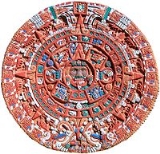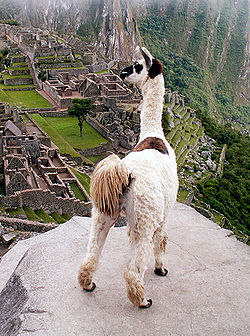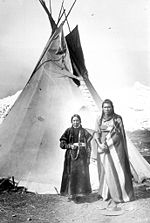
Native American Contributions
Encyclopedia
A
abstract artAbstract art
Abstract art uses a visual language of form, color and line to create a composition which may exist with a degree of independence from visual references in the world. Western art had been, from the Renaissance up to the middle of the 19th century, underpinned by the logic of perspective and an...
- Abstract art was used by nearly all tribes and civilizations of North and South America. Native American art was believed to be primitive until the 1990s, when it served as inspiration for the modern American abstract art movement.
adobe
Adobe
Adobe is a natural building material made from sand, clay, water, and some kind of fibrous or organic material , which the builders shape into bricks using frames and dry in the sun. Adobe buildings are similar to cob and mudbrick buildings. Adobe structures are extremely durable, and account for...
- Adobe was used by the peoples from South America, Mesoamerica, and up to Southwestern tribes of the U.S. It is estimated that it was developed around the year 3000 BC.
almanacs- Almanacs were invented independently by the Maya. Their culture arose and they began using them around 3,500 years ago, while Europeans are known to have created written almanacs only after 1150 AD. Almanacs are books containing meteorological and astronomical information, which the Maya used in various aspects of their life.
anesthetics- American Indians used coca, peyote, datura and other plants for partial or total loss of sensation or conscious during surgery. Non-Indian doctors had effective anesthetics only after the mid-19th century. Before this, they either had to perform surgery while the patient felt pain or knock the patient out.
B
ballBall
A ball is a round, usually spherical but sometimes ovoid, object with various uses. It is used in ball games, where the play of the game follows the state of the ball as it is hit, kicked or thrown by players. Balls can also be used for simpler activities, such as catch, marbles and juggling...
s, rubber- The Olmec produced rubber balls around 1700 BC. They were the first people to develop and play with rubber balls as well as manufacture other objects of rubber.
balsa wood-
barbecue
Barbecue
Barbecue or barbeque , used chiefly in the United States, Canada, the United Kingdom, New Zealand and Australia is a method and apparatus for cooking meat, poultry and occasionally fish with the heat and hot smoke of a fire, smoking wood, or hot coals of...
s-
basketball
Basketball
Basketball is a team sport in which two teams of five players try to score points by throwing or "shooting" a ball through the top of a basketball hoop while following a set of rules...
- Basketball was played by the Olmec 3,000 years ago. The game followed the Olmec's creation of the rubber ball. See Mesoamerican ballgame
Mesoamerican ballgame
The Mesoamerican ballgame or Tlatchtli in Náhuatl was a sport with ritual associations played since 1,000 B.C. by the pre-Columbian peoples of Ancient Mexico and Central America...
for more information on this ancient sport.
C
calendarCalendar
A calendar is a system of organizing days for social, religious, commercial, or administrative purposes. This is done by giving names to periods of time, typically days, weeks, months, and years. The name given to each day is known as a date. Periods in a calendar are usually, though not...
s- Were developed by throughout North America, Mesoamerica, and South America. They are known to have been in used since 600 BC. American Indian calendars were so precise that by the 5th century BC they were only 19 minutes off.
chewing gum
Chewing gum
Chewing gum is a type of gum traditionally made of chicle, a natural latex product, or synthetic rubber known as polyisobutylene. For economical and quality reasons, many modern chewing gums use rubber instead of chicle...
- American Indians in New England introduced the settlers to chewing gum made from the spruce tree. The Mayans, on the other hand, were the first people to use latex gum; better known to them as chicle
Chicle
Manilkara chicle is a tropical evergreen tree native to Mexico and Central America. The tree ranges from Veracruz in Mexico south to Atlántico in Colombia...
.
chocolate
Chocolate
Chocolate is a raw or processed food produced from the seed of the tropical Theobroma cacao tree. Cacao has been cultivated for at least three millennia in Mexico, Central and South America. Its earliest documented use is around 1100 BC...
- The Mayans were the first to drink cocoa. This tradition was later passed on to the Aztec's who called the beverage xocalatl. Natives in mesoamerica introduced it to the Spanish and Portuguese, but they kept the beloved xocalatl from the rest of Europe for nearly a century.
corn (maize)
Maize
Maize known in many English-speaking countries as corn or mielie/mealie, is a grain domesticated by indigenous peoples in Mesoamerica in prehistoric times. The leafy stalk produces ears which contain seeds called kernels. Though technically a grain, maize kernels are used in cooking as a vegetable...
- The domestication of maize, now cultivated throughout the world, is one of the most influential technological contributions of Mesoamericans.
cornmeal
Cornmeal
Cornmeal is flour ground from dried maize or American corn. It is a common staple food, and is ground to fine, medium, and coarse consistencies. In the United States, the finely ground cornmeal is also referred to as cornflour. However, the word cornflour denotes cornstarch in recipes from the...
-
D
dog breeds- Dog breeds believed to have been bred by Native Americans are the xochiocoyotl (coyoteCoyote
The coyote , also known as the American jackal or the prairie wolf, is a species of canine found throughout North and Central America, ranging from Panama in the south, north through Mexico, the United States and Canada...
), xoloitzcuintli (known as xolo or Mexican hairless
Mexican Hairless Dog
The Mexican Hairless Dog is a rare, hairless breed of dog, the size of which varies greatly. It is also known as Xoloitzcuintle .-History:...
), chihuahua
Chihuahua (dog)
The ' is the smallest breed of dog and is so named for the state of Chihuahua in Mexico. Chihuahuas come in a wide variety of sizes, head shapes, colors and coat lengths.-History:...
, the Carolina dog
Carolina Dog
The Carolina Dog, or American Dingo, is a landrace or naturally selected type of dog which was discovered living as a wild dog or free roaming dog by Dr Lehr.J. Brisbin. CDs are now bred and kept in captive collections or packs. They were discovered during the 1970s living in isolated stretches...
, and the Alaskan malamute
Alaskan Malamute
The Alaskan Malamute is a generally large breed of domestic dog originally bred for use as a utilitarian dog and later an Alaskan sled dog. They are sometimes mistaken for a Siberian Husky, but in fact are quite different in many ways...
.
E
embalmingEmbalming
Embalming, in most modern cultures, is the art and science of temporarily preserving human remains to forestall decomposition and to make them suitable for public display at a funeral. The three goals of embalming are thus sanitization, presentation and preservation of a corpse to achieve this...
– Egyptians are known for mummification, which began around 2000 BC. In what is now Chile however, the Chinchoro are known to have been embalming and mummifying their dead since 5000 BC, which would make them the world's earliest embalmers. Embalming is using preservatives to prevent decay of the body.
G
Geographical Names- Native Americans have had a major impact in names of locations and places commonly used today. There are 26 states in the United States alone whose names derive from Native Americans. Most notable however, are the countries of CanadaCanada
Canada is a North American country consisting of ten provinces and three territories. Located in the northern part of the continent, it extends from the Atlantic Ocean in the east to the Pacific Ocean in the west, and northward into the Arctic Ocean...
and Mexico
Mexico
The United Mexican States , commonly known as Mexico , is a federal constitutional republic in North America. It is bordered on the north by the United States; on the south and west by the Pacific Ocean; on the southeast by Guatemala, Belize, and the Caribbean Sea; and on the east by the Gulf of...
. Names do not limit themselves to political states; there are also mountains, rivers, cities, lakes, and counties deriving from indigenous terms. For a full list see Native American Geographical Names.
Gold plating - The Moche
Moche
'The Moche civilization flourished in northern Peru from about 100 AD to 800 AD, during the Regional Development Epoch. While this issue is the subject of some debate, many scholars contend that the Moche were not politically organized as a monolithic empire or state...
dissolved gold using an Alum
Alum
Alum is both a specific chemical compound and a class of chemical compounds. The specific compound is the hydrated potassium aluminium sulfate with the formula KAl2.12H2O. The wider class of compounds known as alums have the related empirical formula, AB2.12H2O.-Chemical properties:Alums are...
/Saltpetre
Potassium nitrate
Potassium nitrate is a chemical compound with the formula KNO3. It is an ionic salt of potassium ions K+ and nitrate ions NO3−.It occurs as a mineral niter and is a natural solid source of nitrogen. Its common names include saltpetre , from medieval Latin sal petræ: "stone salt" or possibly "Salt...
/Salt
Salt
In chemistry, salts are ionic compounds that result from the neutralization reaction of an acid and a base. They are composed of cations and anions so that the product is electrically neutral...
mixture which was then deposited onto copper vessels.
Government:
Indian governments in eastern North America, particularly the League of the Iroquois, served as models of federated representative democracy to the Europeans and the American colonists. The United States government is based on such a system, whereby power is distributed between a central authority (the federal government) and smaller political units (the states).
Historians have suggested the Iroquois system of government influenced the development of the Articles of Confederation and the United States Constitution. In 1988, the United States Congress passed a resolution to recognize the influence of the Iroquois League upon the Constitution and Bill of Rights.
H
hammocks- Hammocks were commonly used in the Caribbean, South and Central America at first contact with Europeans. The Spanish liked the comfortable way of sleeping and adopted them. Europeans eventually used them as the primary way of sleeping on ships.hockey
Hockey
Hockey is a family of sports in which two teams play against each other by trying to maneuver a ball or a puck into the opponent's goal using a hockey stick.-Etymology:...
- Both field hockey and ice hockey are based on a game called shinny
Shinny
Shinny is an informal type of hockey played on ice or the street. There are no formal rules or specific positions, and generally, there are no goaltenders. The goal areas at each end may be marked by nets, or simply by objects, such as blocks of snow, stones, etc...
. This American Indian stickball game was played throughout North America well before the European arrival.
horse breeds- Appaloosa
Appaloosa
The Appaloosa is a horse breed best known for its colorful leopard-spotted coat pattern. There is a wide range of body types within the breed, stemming from the influence of multiple breeds of horses throughout its history. Each horse's color pattern is genetically the result of various spotting...
and Pinto
Pinto horse
A pinto horse has a coat color that consists of large patches of white and any other color. The distinction between "pinto" and "solid" can be tenuous, as so-called "solid" horses frequently have areas of white hair. Various cultures throughout history appear to have selectively bred for pinto...
.
L

Lacrosse
Lacrosse is a team sport of Native American origin played using a small rubber ball and a long-handled stick called a crosse or lacrosse stick, mainly played in the United States and Canada. It is a contact sport which requires padding. The head of the lacrosse stick is strung with loose mesh...
-
llamas- Indigenous people from Peru domesticated llamas in around 5000 BC.
R
rubber balloons - The Olmec were the first people to use rubber balloons. Their civilization arose in BC 1700 in the Yucatan Peninsula.S
salsaSalsa (sauce)
Salsa may refer to any type of sauce. In American English, it usually refers to the spicy, often tomato based, hot sauces typical of Mexican and Central American cuisine, particularly those used as dips. In British English, the word typically refers to salsa cruda, which is common in Mexican ,...
-
spinning top- North American Indians invented the spinning top. A device used as a toy and made out of wood.
T

Tipi
A tipi is a Lakota name for a conical tent traditionally made of animal skins and wooden poles used by the nomadic tribes and sedentary tribal dwellers of the Great Plains...
- A cone shaped, portable dwelling popularized by Native Americans of the Great Plains. Tipis were warm, durable and comfortable and could be easily broken down and packed. A settlement could be ready to move in about one hour.
tomato
Tomato
The word "tomato" may refer to the plant or the edible, typically red, fruit which it bears. Originating in South America, the tomato was spread around the world following the Spanish colonization of the Americas, and its many varieties are now widely grown, often in greenhouses in cooler...
-
tortillas- this staple food well known today was used throughout Mesoamerican and Southwestern cultures. Although they were mainly made of corn, squash and amaranth were also popular among the natives. The tortillas were wrapped around different fillings such as avocado. Today this has resulted in the creation of the modern taco, burrito, and enchilada.
See also
- History of United States patent lawHistory of United States patent law"To promote the Progress of Science and useful Arts, by securing for limited Times to Authors and Inventors the exclusive Right to their respective Writings and Discoveries;" From the United States Constitution, Article I, Section 8, Clause 8....
- Lemelson–MIT Prize
- NASA spinoffNASA SpinoffA NASA spin-off is a spin-off of technology that has been commercialized through NASA funding, research, licensing, facilities, or assistance. NASA also publishes an annual journal titled Spinoff which features products whose development can be linked to NASA, for example through NASA funding ,...
- National Inventors Hall of FameNational Inventors Hall of FameThe National Inventors Hall of Fame is a not-for-profit organization dedicated to recognizing, honoring and encouraging invention and creativity through the administration of its programs. The Hall of Fame honors the men and women responsible for the great technological advances that make human,...
- Science and technology in the United StatesScience and technology in the United StatesThe United States came into being around the Age of Enlightenment , a period in which writers and thinkers rejected the superstitions of the past. Instead, they emphasized the powers of reason and unbiased inquiry, especially inquiry into the workings of the natural world...
- Technological and industrial history of the United States
- Timeline of United States discoveriesTimeline of United States discoveriesTimeline of United States discoveries encompasses the breakthroughs of human thought and knowledge of new scientific findings, phenomena, places, things, and what was previously unknown to exist...
- United States Patent and Trademark OfficeUnited States Patent and Trademark OfficeThe United States Patent and Trademark Office is an agency in the United States Department of Commerce that issues patents to inventors and businesses for their inventions, and trademark registration for product and intellectual property identification.The USPTO is based in Alexandria, Virginia,...
- United States patent lawUnited States patent lawUnited States patent law was established "to promote the Progress of Science and useful Arts, by securing for limited Times to Authors and Inventors the exclusive Right to their respective Writings and Discoveries;" as provided by the United States Constitution. Congress implemented these...
- Yankee ingenuityYankee ingenuityYankee ingenuity is an American English reference to the self-reliance of early colonial settlers of New England, United States. It describes an attitude of make-do with materials on hand. It is inventive improvisation, adaptation and overcoming of dire straits when faced with a dearth of...

